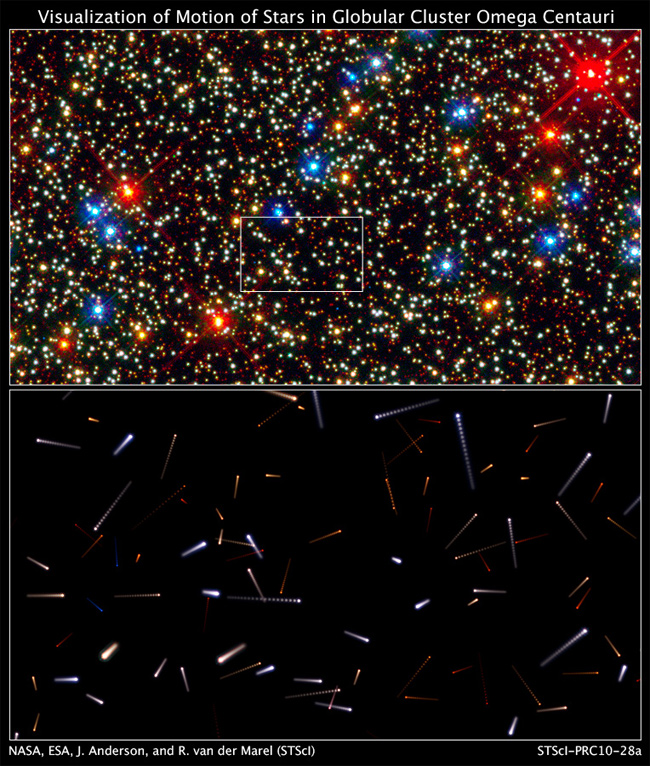Hubble 'Time Machine' Looks 10,000 Years Into Future

Astronomers have created a cosmic time machine of sorts toproject what part of the universe is going to look like 10,000 years into thefuture.
Using observations from the Hubble Space Telescope,scientists have calculated how stars in the globular cluster Omega Centauriwill move for millennia to come.
When it was first catalogued by the ancient Roman astronomerPtolemy 2,000 years ago, Omega Centauri was thought to be a single star. Now thiscluster, located almost 16,000 light-years from Earth in our Milky Way galaxy,is known to be a swarm of about 10 million stars, all orbiting a common centerof gravity. [Video:Hubble's vision of Omega Centauri's future]
By analyzing archived imagestaken over a four-year period by Hubble's Advanced Camera for Surveys,astronomers have made the most accurate measurements yet of the motions of morethan 100,000 cosmic inhabitants of the globularcluster, the largest survey to date to study the movement of stars in anycluster.
"It takes high-speed, sophisticated computer programsto measure the tiny shifts in the positions of the stars that occur in onlyfour years' time," said astronomer Jay Anderson of the Space TelescopeScience Institute in Baltimore, Md., who conducted the study with fellow STScI astronomerRoeland van der Marel. "Ultimately, though, it is Hubble's razor-sharpvision that is the key to our ability to measure stellar motions in thiscluster."
The astronomers used the Hubble images, which were taken in2002 and 2006, to make a video simulation of the frenzied motion of thecluster's stars. The simulation shows the stars' projected migration over thenext 10,000 years.
Identified as a globular star cluster in 1867, OmegaCentauri is one of roughly 150 such clusters in our Milky Way Galaxy.
Breaking space news, the latest updates on rocket launches, skywatching events and more!
The behemoth stellar grouping is the biggest and brightestglobular cluster in the Milky Way, and one of the few that can be seenby the unaided eye. Omega Centauri is located in the constellationCentaurus and is viewable in the southern skies.
- Video: Fast-Forwarding the Future of a Globular Cluster
- Images ? Fantastic Views of Alien Galaxies
- New Tips to See Ancient Star Clusters With Telescopes

Space.com is the premier source of space exploration, innovation and astronomy news, chronicling (and celebrating) humanity's ongoing expansion across the final frontier. Originally founded in 1999, Space.com is, and always has been, the passion of writers and editors who are space fans and also trained journalists. Our current news team consists of Editor-in-Chief Tariq Malik; Editor Hanneke Weitering, Senior Space Writer Mike Wall; Senior Writer Meghan Bartels; Senior Writer Chelsea Gohd, Senior Writer Tereza Pultarova and Staff Writer Alexander Cox, focusing on e-commerce. Senior Producer Steve Spaleta oversees our space videos, with Diana Whitcroft as our Social Media Editor.
